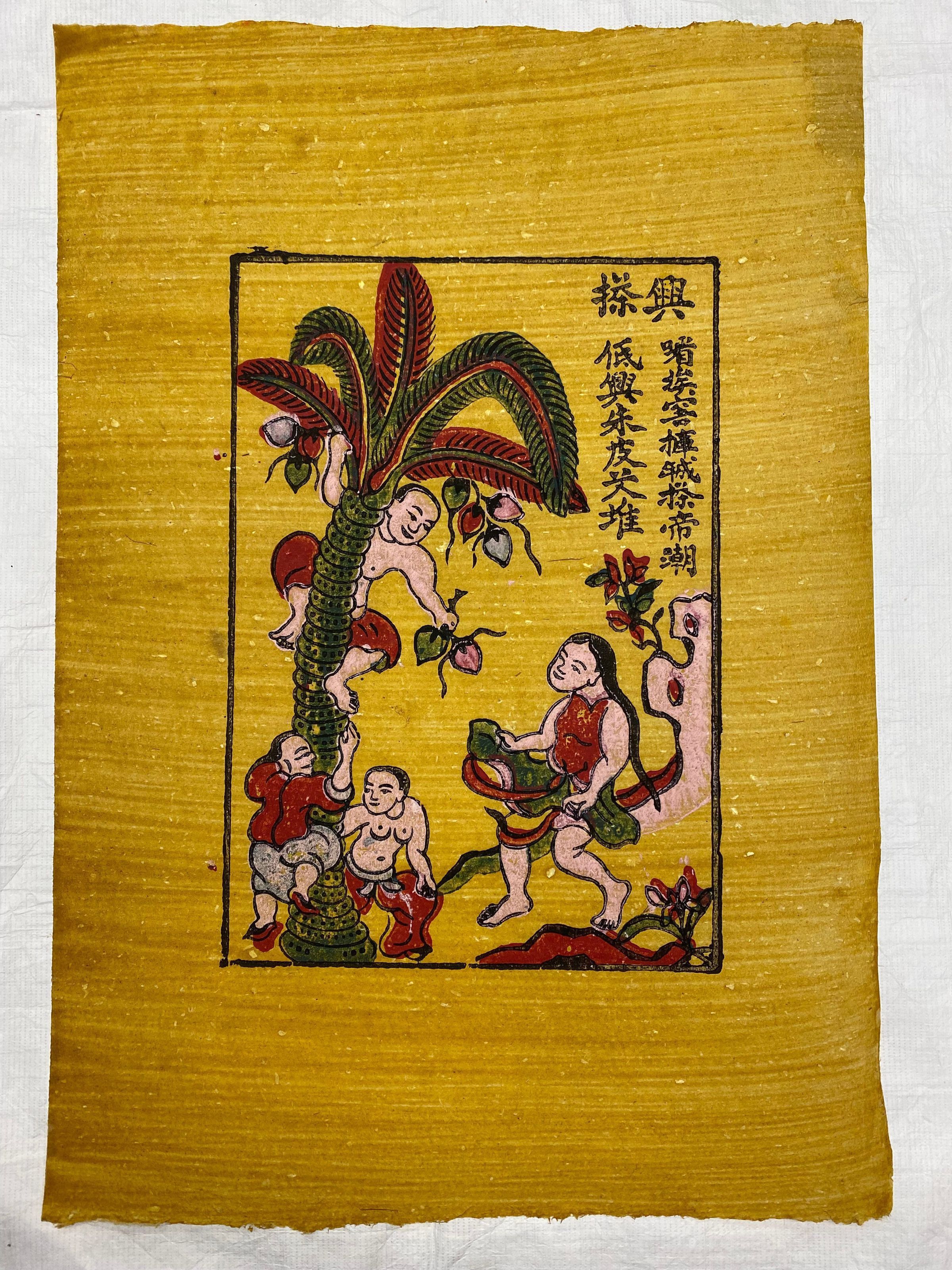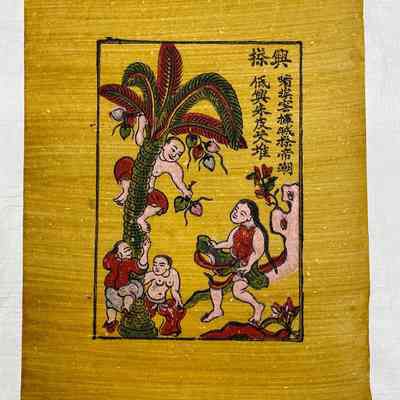Name/Title
Đông Hồ Portfolio Hứng Dừa (Picking Coconuts)Entry/Object ID
2019.P-G.078ODescription
Traditional Vietnamese folk woodblock print on plant fibrous paper vertically depicts the story of catching coconuts. A female figure walks through a rocky terrain landscape holding her dress before her to catch the coconuts a male figure holds down from the top of a palm tree. Two other similar male figures are depicted at the bottom of the tree to emulate the act of the one male figure climbing the tree. Vietnamese characters are depicted on the left top portion of the printed image vertically.Context
This painting symbolizes a happy family and the unity within it. It depicts a father picking coconuts and hanging them on a tree while the wife catches them in her skirt, and the children try to climb the tree like their father. The painting reflects themes of family support, shared responsibility, and the strength of familial bonds. It symbolizes the simplicity of family life, where each member contributes and shares the burdens. It also carries deeper cultural meanings, including the philosophy of yin and yang and agricultural fertility beliefs. This artwork is often displayed during the Lunar New Year as a symbol of hope, happiness, and family unity.
The two Chữ Nôm verses in the painting say: “Khen ai khéo dựng lên dừa, Đấy trèo đây hứng cho vừa một đôi” which translates to:
"Praise to whoever skillfully set up the coconut, Here a climber, there a catcher, just right for a pair."
-Chữ Nôm is a Vietnamese writing system with a mix of standard Chinese characters and newly created characters for native Vietnamese words. It was widely used between the 15th and 19th centuries, mostly only by the educated elite.
From insert in boxset about series, directly transcribed:
A Brief Overview of "Ðông Hồ" Folk Paintings:
The "Dong Ho" folk paintings have been around for nearly 500 years. The themes of these paintings were inspired by everyday life and created by artisans' observations and experiences.
The main themes include:
Congratulatory paintings, which reflect the common wishes of people: a happy family, longevity, wealth, and prosperity, as seen in paintings such as Phú Quý (Wealth and Nobility), Vinh Hoa (Glory), Gà Đàn (Hen and Chicks), Lợn Đàn (Pigs).
Paintings depicting festivals and traditional activities, such as wrestling contests, drum carrying, buffalo fighting, as well as daily life scenes like đánh ghen (a fight between women over a man), hứng dừa (picking coconuts), thầy đồ cóc (the frog teacher), đám cưới chuột (a mouse wedding), and folklore stories such as Trê Cóc Kiện Nhau (Catfish and Frog Suing Each Other), Đinh Bộ Lĩnh (founding emperor of the short-lived Đinh dynasty), and Bà Triệu (legendary Vietnamese heroine).
Over many generations, artisans creatively used available local materials to craft these artworks.
Initially, the images were carved onto wood, usually wood from the thị tree, thừng mực wood, or vàng tâm wood. These carvings were then printed onto dó paper, which had been coated with a special resin. Dó paper is handmade from the bark of the dó tree, while the resin is made from the shells of dead mollusks, cleaned, crushed, and mixed with rice paste. The mixture was applied to the paper with a brush made from dry pine leaves, creating the texture that gives the painting life.
The artisans used only a few natural materials to create the colors: red from clay, green from tràm leaves or copper rust, white from diệp powder, yellow from the hoè tree flowers, and black from ash made from bamboo leaves or rice straw.
The patterns were carefully printed and harmoniously arranged, creating a unique identity. In the rich collection of Vietnamese folk art, the "Dong Ho" paintings stand out as a distinct form of expression, originating from the village of Song Ho in Thuận Thành district, Bắc Ninh province.Collection
Palmeri-Goodstein Research Print CollectionMade/Created
Artist Information
Artist
Tranh Dan GianRole
ArtistLexicon
Search Terms
Longevity, Life, Abundance, Wealth, Luck, Plants, Tree, Coconut, Fruit, Fruit of labors, Laboring, Labor, LoveDimensions
Height
14-7/8 inHeight
8-7/8 inWidth
6-1/8 in
